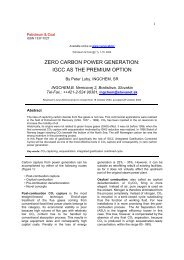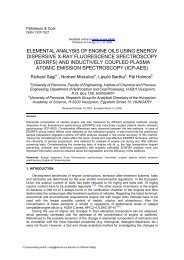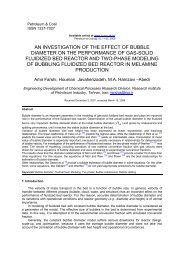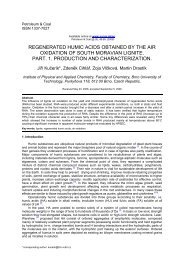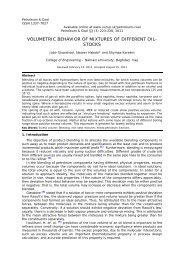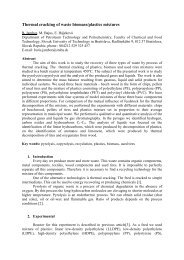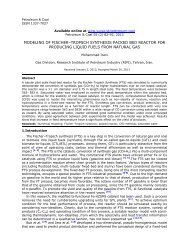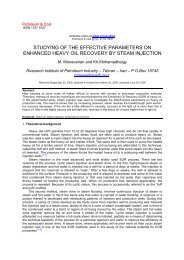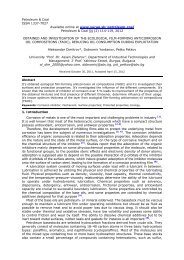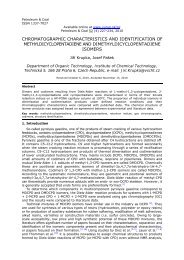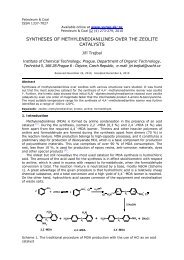permeability estimation and hydraulic zone pore structures
permeability estimation and hydraulic zone pore structures
permeability estimation and hydraulic zone pore structures
You also want an ePaper? Increase the reach of your titles
YUMPU automatically turns print PDFs into web optimized ePapers that Google loves.
Petroleum & CoalISSN 1337-7027Available online at www.vurup.sk/petroleum-coalPetroleum & Coal 54 (1) 52-58, 2012PERMEABILITY ESTIMATION AND HYDRAULIC ZONE PORESTRUCTURES IDENTIFICATION USING CORE AND WELL LOGSDATAY.B. Adeboye 1 , C.E. Ubani 2 , K.K. Farayola 11 Department of Petroleum <strong>and</strong> Gas Engineering, University of Lagos, Akoka, Lagos, Nigeria2 Department of Petroleum <strong>and</strong> Gas Engineering, University of Port-Harcourt, P/H, Nigeria.corresponding author Email: yadeboye@unilag.edu.ngReceived November 24, 2011, Accepted January 15, 2012AbstractAn improved methodology to accurately estimate <strong>permeability</strong> from well log devices, with commonlyavailable core log data is presented. Core <strong>permeability</strong> <strong>and</strong> porosity data were used to identify threedifferent <strong>hydraulic</strong> <strong>zone</strong>s namely: micro, meso <strong>and</strong> macro <strong>pore</strong>s respectively with unique <strong>pore</strong> <strong>structures</strong>.Selected logging tools showed different responses for each <strong>hydraulic</strong> <strong>zone</strong>. Multi-dimensional data basethat relate four logging values to core <strong>permeability</strong> in order to provide relationship for <strong>permeability</strong>predictions from log where core is not available was constructed. The obtained predictions are moreaccurate than ones with other methods due to the fact that <strong>permeability</strong> transforms are provided foreach <strong>pore</strong> type <strong>and</strong> however, <strong>pore</strong> throat size is considered. Well log <strong>permeability</strong> <strong>estimation</strong>s usingthis method are used to map <strong>permeability</strong> for improved reservoir simulation models, well test, <strong>and</strong><strong>permeability</strong> <strong>estimation</strong> <strong>and</strong> more importantly, well completion optimization operations.Keywords: Permeability; Core; Well log; Hydraulic; Pore structure.1. IntroductionPermeability (a measure of fluid conductivity in porous medium) is a critical parameter inmodels for reservoir characterization, reservoir <strong>estimation</strong> <strong>and</strong> production forecast. Estimationof <strong>permeability</strong> in a reservoir is a complex task <strong>and</strong> a poorly estimated <strong>permeability</strong> will makethe model inaccurate <strong>and</strong> unreliable thus, affecting the degree of success of many oil <strong>and</strong> gasoperations based on such model. However, knowing <strong>permeability</strong> is significant for developingan effective reservoir description <strong>and</strong> quality. Formation <strong>permeability</strong> controls the requirementsinvolving such operations such as well completion, stimulation <strong>and</strong> reservoir managements.Accurate well log <strong>permeability</strong> is desirable because logs exist for all wells <strong>and</strong> because<strong>permeability</strong> is one of the most important parameters used to define reservoir performance,st<strong>and</strong>ard methods of estimating <strong>permeability</strong> from well logs are not accurate enough to providereliable values <strong>and</strong> are not widely used. Typically, empirical transforms are developed betweenporosity, irreducible water saturation (SW irr ) <strong>and</strong> <strong>permeability</strong> with the underst<strong>and</strong>ing thatreflects internal <strong>pore</strong> surface roughness. However, It is possible to predict <strong>permeability</strong> within asingle reservoir without diagenetic alteration or complex <strong>pore</strong> types, but a dependable <strong>permeability</strong><strong>estimation</strong> technique, to the best of my knowledge, not available in literature.2. Developed methodology2.1 Modeling methodologyPermeability has been measured as an indicator of fluid transmissibility in rock or soil sincethe concept was introduced by Darcy [6] . The Darcy is the st<strong>and</strong>ard unit of <strong>permeability</strong>representing the ability of a rock to deliver one cm 3 of fluid across an area of one cm 2 in atime of one second with an imposed pressure differential of one atmosphere for each centimeterof sample length. Permeability is affected by: fluid flow path length per unit sample length
Y. B. Adeboye, C. E. Ubani, K. K. Farayola/Petroleum & Coal 54(1) 52-58, 2012 53as defined by tortuosity; by the internal <strong>pore</strong> surface roughness <strong>and</strong> shape as defined by specificsurface area per unit <strong>pore</strong> volume; <strong>and</strong> by the mean <strong>hydraulic</strong> radius of <strong>pore</strong> throats in fluidconduits. The rock properties above are adequate for defining a <strong>permeability</strong> relationshipwithin a reservoir.A widely used equation linking porosity <strong>and</strong> <strong>permeability</strong> was proposed in 1927 by Kozenyin a model which represents fluid flow in capillary tubes. Kozeny derived his model equationby algebraically combining Darcy <strong>and</strong> Poiseuille’s equation to yieldk35(1 )S2 2pv(1)Carman [9] , developed a more closely representative reservoir conditions using the geometryof a spherical bead pack, altered the constants from five to two. A large deficiency with theseequations is the specific surface area <strong>and</strong> <strong>pore</strong> volume which have direct link with <strong>permeability</strong>in clean s<strong>and</strong>stones well sorted grains were not considered.Coates <strong>and</strong> Dumanoir [3] developed a <strong>permeability</strong> relationship to ensure zero <strong>permeability</strong>at zero porosity <strong>and</strong> at 100 % water saturation. However, Timur [2] developed equationwhich is widely used in porosity to <strong>permeability</strong> transform was used here to compare empirical<strong>permeability</strong> <strong>estimation</strong>s to those made with statistical methods.0.136( 100)k 2( )S wir4 0.4Empirical <strong>permeability</strong> relationships do not directly include <strong>pore</strong> throat size. This is a problembecause <strong>pore</strong> throats have more influence over <strong>permeability</strong> than other <strong>pore</strong> attributes. Withconsideration for <strong>pore</strong> throat size, Tiab [7] developed the following <strong>permeability</strong> relationship givenin equation 3 where H c (<strong>hydraulic</strong> character) is a variable.k H c3( 1)2Hydraulic character is a variable that includes the “lumped” effect of mean <strong>pore</strong> throat/<strong>hydraulic</strong> radius; <strong>pore</strong> surface area per volume (S 2 pv ); <strong>and</strong> tortuosity (T). This essentialvariable can be approximated by porosity - <strong>permeability</strong> relationships; or measured by PetrographicImage Analyses (PIA), capillary pressure data or surface adsorption measurements.In this study, reservoirs are subdivided into layers <strong>and</strong> described as computer models forpredicting reservoir performance. The major challenge was in the model development wasthe integration of the engineering flow model with the geological faces model. However, thisrevealed that reservoirs can either be layered with geological knowledge or mathematicallywith knowledge of <strong>hydraulic</strong> character. Each face was considered to have unique <strong>hydraulic</strong>character with similar log response <strong>and</strong> fluid flow characteristics.Equation (3) was then modified algebraically to yield a mathematical explanation for amethodology to use porosity <strong>and</strong> <strong>permeability</strong> measurements to group reservoirs into <strong>hydraulic</strong><strong>zone</strong>s. Both sides of Eq. (3) are divided by porosity to yield Eq. (4).k2( 1) (4)2H cThe square root of each side of the equation 4 was then taken to yield Eq. (5).It should be noted that the square root of k/ϕ is Leverett’s mean <strong>hydraulic</strong> radius <strong>and</strong> isan approximation of the mean <strong>pore</strong> throat size in the core plug on which <strong>permeability</strong> wasmeasured.(2)(3)k10.5( 1)Hc(5)
Y. B. Adeboye, C. E. Ubani, K. K. Farayola/Petroleum & Coal 54(1) 52-58, 2012 54Taking the logarithm of each term above yields Eq. (6) in the form of a straight line, wherey=mx + c. Core porosity <strong>and</strong> <strong>permeability</strong> data are plotted with log – log coordinates into<strong>hydraulic</strong> <strong>zone</strong> groupings with boundaries of slope one. Notice that intercept b is defined by<strong>hydraulic</strong> character.Inspection of Eq. (6) shows that y position is controlled by <strong>pore</strong> throat size (square rootk/ϕ) <strong>and</strong> that x position is controlled by <strong>pore</strong> volume divided by to bulk volume (ϕ/(l -ϕ)).klog =1log(1 log)10.5H c(6)This grouping of <strong>hydraulic</strong> <strong>zone</strong>s is important because it places constraints on how the<strong>hydraulic</strong> <strong>zone</strong>s are selected <strong>and</strong> determines how much <strong>permeability</strong> databases would beneeded to be constructed. Hydraulic <strong>zone</strong>s so selected from core <strong>permeability</strong> <strong>and</strong> porositydata must agree with core geologic descriptions. With this mathematical expression, It ispossible to describe many different <strong>hydraulic</strong> layers - depending on the scale of the reservoirdescription. It is however, not practical to consider resolving <strong>hydraulic</strong> layers which are toosmall to be measured by well logs.Well log measured <strong>hydraulic</strong> <strong>zone</strong>s are themselves scaled up for reservoir simulation. Thereare rarely more than four <strong>hydraulic</strong> <strong>zone</strong>s discernible with logs. Macro, meso, micro <strong>pore</strong>s,<strong>and</strong> non-flow layers are considered.2.2 Method of ApplicationPermeability <strong>estimation</strong>s are used to determine where wells should be completed; todetermine productive intervals <strong>and</strong> heights for well test <strong>permeability</strong> <strong>estimation</strong>s; <strong>and</strong> tocalculate layer average <strong>permeability</strong> for reservoir simulation. Permeability <strong>estimation</strong> fromlogs, even though they agree well with core <strong>permeability</strong> must be placed in context. Logmeasurementsare taken from wellbores which are very far between <strong>and</strong> <strong>permeability</strong><strong>estimation</strong>s must ultimately be determined between wells. Log derived <strong>permeability</strong> areintegrated with well test <strong>permeability</strong>, history matched simulator <strong>permeability</strong> or with<strong>permeability</strong> model in three dimensions with geologic modeling software to achieve thedistribution of <strong>permeability</strong> in a reservoir. Log <strong>permeability</strong> provides an excellent startingpoint for building the most physically correct reservoir models.However, correct <strong>permeability</strong> <strong>estimation</strong> can be achieved by well logs with proper selection<strong>and</strong> calibration of logs by core data. Core porosity <strong>and</strong> <strong>permeability</strong> are used to recognizedifferent <strong>hydraulic</strong> <strong>zone</strong>s. Well logs are selected that respond differently to each <strong>hydraulic</strong><strong>zone</strong> <strong>and</strong> databases are constructed for each <strong>hydraulic</strong> <strong>zone</strong> with core <strong>permeability</strong> <strong>and</strong> logresponses in “key” wells. Permeability predictions are made with logs at depths without corein key or offset wells with st<strong>and</strong>ard log suites. Two porosity devices, a gamma ray log <strong>and</strong>resistivity logs are the normal logs required.2.3 Simulation ApproachLaboratory <strong>permeability</strong> <strong>and</strong> porosity data are used to determine the number of <strong>hydraulic</strong><strong>zone</strong>s <strong>and</strong> are linked to log responses so that <strong>permeability</strong> can be estimated directly fromwell logs. This methodology is employed to scale up laboratory <strong>permeability</strong> (measured onsamples of approximately 20 ml volume) to log <strong>permeability</strong> (measured on samples of approximately20 liters or more volume). It is important to recognize that not all core data <strong>and</strong>not all log data are correct <strong>and</strong> that bad data must not be included in predictive databases.Databases must have data from each <strong>hydraulic</strong> <strong>zone</strong> or rock type to be encountered in thereservoir. The entire range of <strong>permeability</strong> to be encountered must also reside in the database;<strong>permeability</strong> values will not be predicted that are greater or smaller than those stored in thedatabase. Approximately 20 to 30 <strong>permeability</strong> values are required for each <strong>hydraulic</strong> <strong>zone</strong>,thus typically providing 120 <strong>permeability</strong> transforms for a reservoir with four <strong>hydraulic</strong> <strong>zone</strong>s.Obviously, if a database contains only 120 <strong>permeability</strong> values, many more <strong>permeability</strong>exist in a reservoir <strong>and</strong> a method was therefore developed to estimate <strong>permeability</strong> that aredifferent from those in the database. Kriging approach was employed for this purpose.
Step 1: Perform quality control on <strong>permeability</strong> <strong>and</strong> porosity data to generate a st<strong>and</strong>ardporosity - <strong>permeability</strong> plot mainly to recognize bad core data. Besides, to identify anyfractured core plugs that exhibit high <strong>permeability</strong> with low porosity. Observe any obviousrock type groupings that are easily identified to give some indications of the number ofpotential <strong>hydraulic</strong> <strong>zone</strong>s.Step 2: Use Eq. (6) to group <strong>permeability</strong> <strong>and</strong> porosity data into <strong>hydraulic</strong> <strong>zone</strong>s <strong>and</strong> choose<strong>hydraulic</strong> <strong>zone</strong>s that represent macro <strong>pore</strong>s (<strong>hydraulic</strong> <strong>zone</strong> 1); meso-<strong>pore</strong>s (<strong>hydraulic</strong> <strong>zone</strong>2); <strong>and</strong> micro <strong>pore</strong>s (<strong>hydraulic</strong> <strong>zone</strong> 3).Step 3: Display the log responses with log estimated <strong>hydraulic</strong> <strong>zone</strong>s to as-certain that logsare responding to differences in <strong>pore</strong> type. Compare the log displayed <strong>and</strong> proportion of each<strong>hydraulic</strong> <strong>zone</strong> with core descriptions. The log representation of <strong>hydraulic</strong> <strong>zone</strong>s should matchgeologic descriptions from “core when core is available. The <strong>hydraulic</strong> <strong>zone</strong> log shows the<strong>pore</strong> type distribution found in the reservoir volume sampled by well logs. The relativeproportions of micro, meso <strong>and</strong> macro <strong>pore</strong>s can be used to determine which relative <strong>permeability</strong><strong>and</strong> capillary pressure curves best represent each reservoir layer.Step 4: Constrict a predictive <strong>permeability</strong> database with unique log responses for eachcore plug <strong>permeability</strong>. The database will have three or four log values for each depth level<strong>and</strong> one laboratory measured <strong>permeability</strong>. The goal is to find unique log responses for a 20liter volume which can be linked to a 20 milliliter core plug for which <strong>permeability</strong> is reported.The entire range of <strong>permeability</strong> in the reservoir must be included in this database.Step 5: Predict <strong>permeability</strong> from log values by comparing to log values stored in the database.There should be a match between log <strong>and</strong> core <strong>permeability</strong> at all <strong>permeability</strong> ranges.When there is a match between all log values at a particular depth level <strong>and</strong> those found inthe database, <strong>permeability</strong> is estimated.3. Case StudiesPermeability <strong>estimation</strong> data presented for s<strong>and</strong>stone reservoirs was used for the study.The <strong>permeability</strong> <strong>estimation</strong>s by Kriging <strong>and</strong> Timur’s porosity - <strong>permeability</strong> transform (Eq.2)are compared. Additionally, foot by foot <strong>permeability</strong> estimates from well logs are comparedto layer average <strong>permeability</strong> from core.4. Results <strong>and</strong> DiscussionsY. B. Adeboye, C. E. Ubani, K. K. Farayola/Petroleum & Coal 54(1) 52-58, 2012 55Results are presented for a single s<strong>and</strong>stone reservoir to allow for comparability betweenvarious <strong>permeability</strong> <strong>estimation</strong> techniques. Many different s<strong>and</strong>stone reservoirs have beenstudied with this method <strong>and</strong> results are consistent with the observation reported in thisstudy. Figure 1 is from a s<strong>and</strong>stone reservoir with both Aeolian <strong>and</strong> fluvial faces. More thaneight different faces were identified. The log <strong>permeability</strong> versus porosity plot shows anapparent strong dependency of <strong>permeability</strong> on porosity with a correlation coefficient r2equals 0.91.Figure 1 Porosity –Permeability PlotFigure 2 Hydraulic Zone Plot
Y. B. Adeboye, C. E. Ubani, K. K. Farayola/Petroleum & Coal 54(1) 52-58, 2012 56This data suggests that it would be possible to estimate <strong>permeability</strong> directly from porositywith linear regression or a single Timur equation. It turns out that there are three different<strong>hydraulic</strong> <strong>zone</strong>s in this reservoir, each requiring different <strong>permeability</strong> transforms.Also, three <strong>hydraulic</strong> <strong>zone</strong>s are shown in Figure 2. The result showed that Hydraulic<strong>zone</strong>,HZ1 is dominated by macro <strong>pore</strong>s; HZ2 by meso <strong>pore</strong>s; <strong>and</strong> HZ3 micro <strong>pore</strong>s. Thevalues of H C used to differentiate <strong>zone</strong>s are selected based on experience as to which <strong>pore</strong>throat radii most commonly provide correct flow <strong>zone</strong>s. The selection of <strong>hydraulic</strong> <strong>zone</strong>s issomewhat an iterative process where log <strong>hydraulic</strong> <strong>zone</strong>s shown in Figure 3 are based onFigure 2 core groupings <strong>and</strong> compared to cores descriptions. However, the identifiedHydraulic <strong>zone</strong>s shown in Figure 3 are used to characterize the larger reservoir volumessampled by well logs to predict the proportions of each <strong>pore</strong> type. This figure shows that logresponses are indeed different for each <strong>hydraulic</strong> <strong>zone</strong> <strong>and</strong> suggests that different logtransform is required for <strong>permeability</strong> <strong>estimation</strong> in each <strong>hydraulic</strong> <strong>zone</strong>.Figure 4 presents core <strong>permeability</strong> values as plotted against log <strong>permeability</strong> values, with anear perfect one to one correlation. The r 2 correlation between core <strong>and</strong> log predicted<strong>permeability</strong> value is 0.99. This plot is evidence that for each <strong>permeability</strong> value measuredon a core plug, there is a unique, set of log responses for a larger sample volume. What hasbeen achieved is a scaling up where core plug volumes have been uniquely tied to log volumes.The software that performs this exercise is a very powerful tool. Linkage of core <strong>and</strong> logmeasurements in this manner has now been performed in tens of reservoirs in more thanone hundred wells.Figure 3 Hydraulic <strong>zone</strong>Figure 4 log vs. core <strong>permeability</strong>A combination of gamma ray, shallow resistivity, <strong>and</strong> density logs was used to provideunique log “fingerprints” for each <strong>permeability</strong> from 0.01 md through 1000 md. In simplisticterms, the gamma ray tool tends to measure <strong>pore</strong> throat properties; the density log measuresmatrix properties; <strong>and</strong> the shallow resistivity log measures <strong>pore</strong> attributes. The key to instructingthese databases is to represent the full range of <strong>permeability</strong> values, with associated logvalues, without having conflicting information in the database. The <strong>permeability</strong> predictivedatabase from Figure 4 provides <strong>permeability</strong> logs as shown in Figure 5. There are accurate<strong>permeability</strong> predictions for the full range of values found in the reservoir. Figure 5 wasgenerated using 319 core measurements of <strong>permeability</strong>. Because of the excellent agreementbetween core <strong>and</strong> log predictions with the full database, it confirms that the log curve
Y. B. Adeboye, C. E. Ubani, K. K. Farayola/Petroleum & Coal 54(1) 52-58, 2012 57presented in Figure 5 is accurate. This curve can be used for comparisons, in this well, toTimur <strong>permeability</strong> <strong>estimation</strong>s <strong>and</strong> to statistical <strong>permeability</strong> with fewer core samples.5. ConclusionsFigure 5 Core log vs. log <strong>permeability</strong> in S<strong>and</strong>stone Reservoir1. A method has been found to link core plug <strong>permeability</strong> to well log measurements inrelational databases. Core plugs of approximately 20ml volume have a <strong>permeability</strong> valuewhich can be uniquely linked to log measurements.2. Well logs respond differently in different <strong>hydraulic</strong> <strong>zone</strong>s.3. If the entire range of <strong>permeability</strong> from all <strong>hydraulic</strong> <strong>zone</strong>s is included in a core - logdatabase, it is possible to predict <strong>permeability</strong> accurately enough to represent changes in<strong>permeability</strong> across a reservoir. Databases constructed at “key” wells can be used to predict<strong>permeability</strong> at offset wells.4. Permeability predictions are good in s<strong>and</strong>stone reservoirs if <strong>permeability</strong> is predictedby Kriging with a multi-dimensional database calibrated for each <strong>hydraulic</strong> <strong>zone</strong>.Permeability predictions from porosity-<strong>permeability</strong> transforms were of little value casestudy presented.5. St<strong>and</strong>ard gamma ray, density, <strong>and</strong> resistivity log suites <strong>and</strong> routine core analysesprovide enough data to predict <strong>permeability</strong> from well logs.Nomenclature:S wir = irreducible water saturation, %H c = <strong>hydraulic</strong> character, dimensionlessHZ = <strong>hydraulic</strong> <strong>zone</strong>k = <strong>permeability</strong>, (md)ϕ = porosity, fractionr 2 = goodness of fit correlationS pv 2 = specific surface area per unit <strong>pore</strong> volume, 1/cm
ReferencesY. B. Adeboye, C. E. Ubani, K. K. Farayola/Petroleum & Coal 54(1) 52-58, 2012 58[1] Ahmed, U.,Crary S.F., Coates, G. R (1991).: “Permeability Estimation: The VariousSources <strong>and</strong> Their Interrelationships,” .Journal Of Petroleum Technology,pp.578-567.[2] Amaefule, J.O., Altunsbay, M., Tiab, D., Kersey, D.G., Keelan, P. K(1993).: EnhancedReservoir Description: Using Core <strong>and</strong> Log Data to Identify Hydraulic (Flow) Units <strong>and</strong>Predict Permeability in Uncored intervals/wells, SPE Paper 26436, presented 68 thAnnual Technical Conference, Oct.,, 93, Houston, Texas.[3] Brooks, C.S. <strong>and</strong> Purcell, W. R.(1952).: “Surface Area Measurements on SedimentaryRocks,” Trans. AIME (1952), pp. 289.[4] Carman, P.C.(1938).: “Fluid Flow Through Granular Beds: Trans. Inst. ChemicalEngineers (1938) , Vol.16, pp.168-88.[5] Coates, G.R. <strong>and</strong> Dumanoir, J.L.(1973).: “A New Approach to Improved Log DerivedPermeability,” Proc., SPWLA Fourteenth Annual Logging Symposium, Lafayette (May6-9, 1973).[6] Morris, R.L. <strong>and</strong> Biggs, W. P.(1967).: “Using Log Derived Values of Water Saturation<strong>and</strong> Porosity,” Proc. SPWLA Eighth Annual. Logging Symposium, Denver (June 12-14, 1967) .[7] Purcell, W. R.(1950).: “Interpretation of Capillary Pressure’’ Trans. AIME (1950), pp.369-371.[8] Timur, A. (1968).: “An Investigation of Permeability, Porosity, <strong>and</strong> Residual WaterSaturation Relationships; Proc., SPWLA Ninth Annual Logging Symposium, NewOrleans (June 23-26, 1968), Paper K.[9] Wyllie, M.R.J. <strong>and</strong> Rose, W.D. (1950).: “Some Theoretical Considerations Related toQuantitative Evaluation of Physical Characteristics of Reservoir Rocks from ElectricalLog Data,” Trans. AIME (1950), Vol. 189, pp.105-118.



